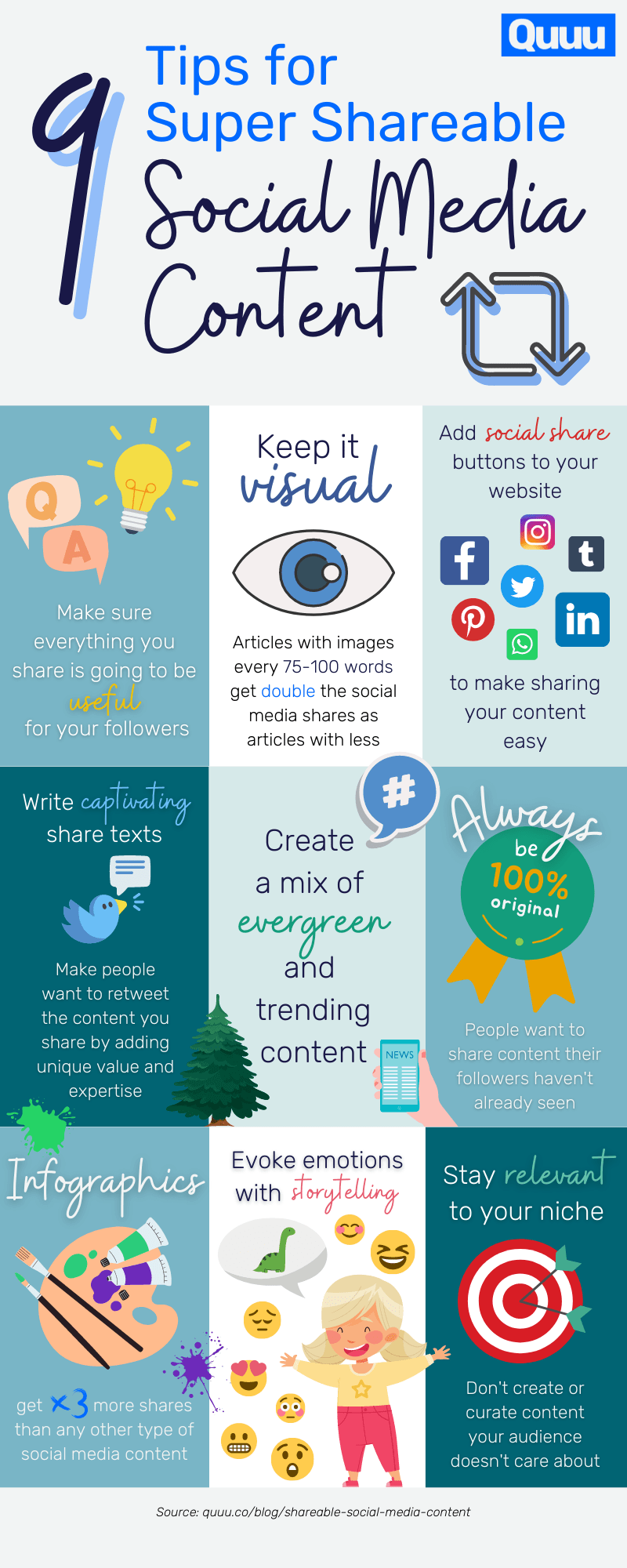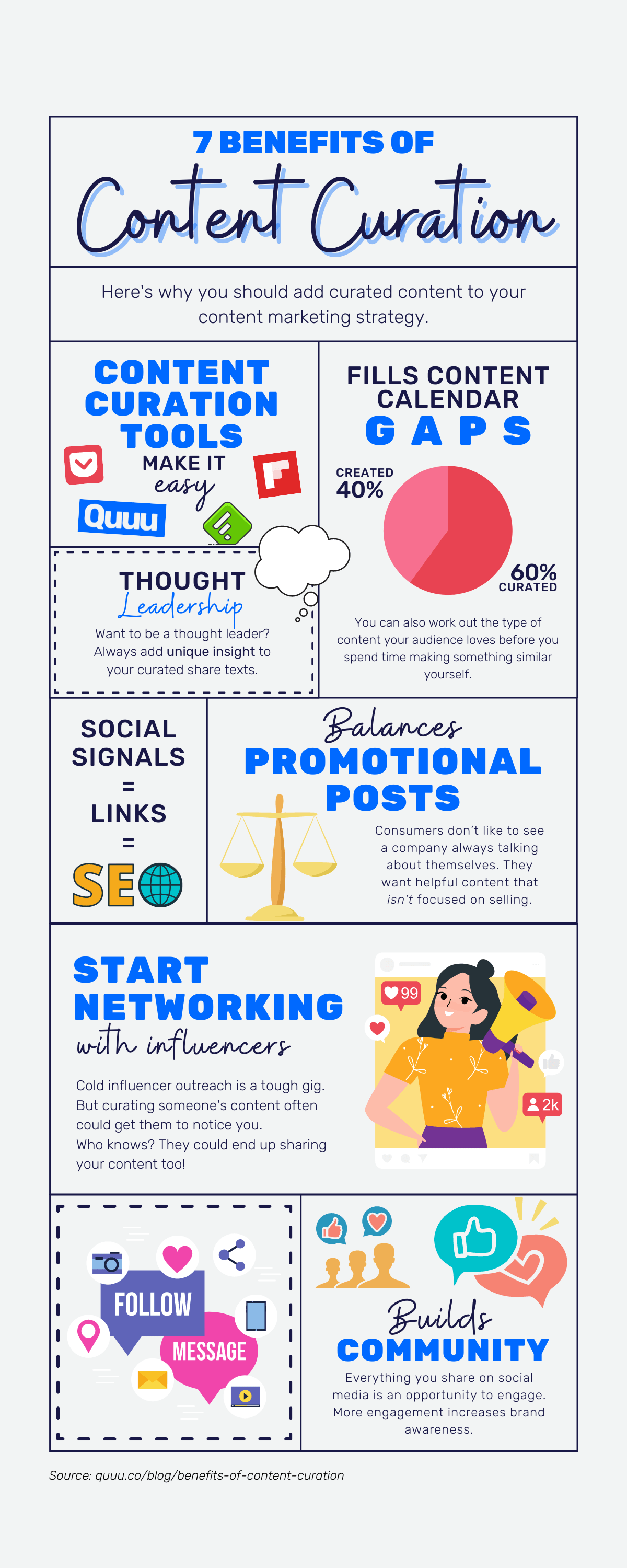Social media can be one of your most powerful marketing channels. One creative social media post can skyrocket brand awareness. Enough of these, and you’ll be on your way to thought leadership.
Content marketing should play a major part in your social media strategy. But getting people to share your social media content is way easier said than done. Whatever platform you’re on, there’s a ton of content to compete with every second.
But nailing it has so many benefits.
Social shares can increase engagement on your social media accounts, entice new followers, and potentially boost your web traffic. (Especially alongside a content promotion tool like Quuu Promote!)
If you want your social media marketing content to be super shareable, check out these 9 tips:
- Make sure it’s useful for your followers
- All social media platforms love visuals
- Add social share buttons to your blog
- Always be original (even when curating!)
- Create a mix of evergreen and trending social media content
- Write captivating share texts
- Infographics – the most shareable types of social media content
- Evoke emotions with storytelling
- Keep all social media content relevant to your niche

1. Make sure social media content is useful for your followers
Effective content solves problems. If you want your target audience to share yours, you have to give them a reason to. Most social media users want to present a certain version of themselves online. So, your content has to fall into that.
Social media is one of the most popular content distribution channels. Shares and reposts are a huge indicator of your marketing strategy’s success. So, you need to make the value of your content immediately clear to people.

Source: Semrush
The content itself doesn’t need to be brief, but it should be obvious at a glance:
- Who created it
- What it’s about
- What the user is going to get from it
Speak directly to your audience with words like “you” and “your”. Include helpful data and stats. Make it easy to read and digest with plenty of line breaks.
If you know your audience well enough, you should understand the type of content they’ll enjoy. If you don’t know them yet – time to start! Customer-centric marketing starts with knowing them inside out.
This is the first piece of the puzzle for creating useful social media content they’ll always want to share.
2. All social media platforms love visuals
46% of businesses say they want to increase their content creation spending in 2022. But more money = more content = more problems. For you, that is!
Your social media content has got to stand out. A wall of text isn’t going to cut it anymore. High-quality visuals are a must. (Even on text-heavy platforms like LinkedIn!) It’s why a lot of people film their podcasts and live stream webinars these days.
After analyzing over 1 million articles, BuzzSumo found that articles with an image once every 75-100 words received double the social media shares as those with less. Gifs and memes can help bring content to life.

Source: GIPHY
37% of marketers agree that creating enough engaging visual content is one of their top struggles. But you don’t have to hire a graphic designer just yet. There are tons of sites and tools that can make finding and creating visual content easy.

Canva or Visme are 2 graphic design platforms that anyone can use. They have hundreds of tutorials and templates for creating on-brand visual content for all social platforms. Even if you’re not at all arty, you’ll fool yourself.
Stock photography is so last decade. But if you just need a simple cover image for your social media content, try Unsplash.
Let’s get visual!
3. Add social share buttons to your blog
Humans love convenience. We click a few times, enter a couple details, and food appears at our door by magic.
Sharing content from your blog to social media can be even faster than that with the help of social sharing buttons. And you don’t even need to create them yourself!
AddThis or ShareThis are both free tools that have done the hard work for you. They connect your blog content to the rest of the world. You can also include extras like:
- Showing the real-time number of shares your content already has
- Follow buttons for your Twitter or Facebook accounts
- Specific image and video content sharing
- Reaction buttons

Source: ShareThis
The next-level version of these (you’ve probably seen) are “Click to Tweet” sharing buttons. Content Marketing Institute uses these CTAs in every blog post.

Source: Content Marketing Institute
With the click of a button, the user is taken to their Twitter feed with the drafted tweet waiting. It includes the selected quote, hashtags, site, and author tags. Plus, a link to the content it came from.
Sharing has never been so convenient. Your Grandma could do it. She already does!

Source: GIPHY
4. Always be original (even when curating!)
The most obvious rule of content marketing is: don’t copy. People want to hear what you’ve got to say. But let’s assume you’ve got that part down.
Your target audience wants to share things their followers haven’t seen before. When you create content, keep this in mind when doing keyword research.
Say the top 3 SERP results for your chosen keywords “social media management” are all lists of tips. This shows that most users are looking for quick bullet points of help managing their social media channels.
Now, try to come at it from another angle. Maybe something like “5 Social Media Management Mistakes Most People Make”.
Break content down into bite-sized chunks. Things that are easy to make a good share text from (we’ll get to that in a sec!)
If you’re curating, it’s a little different. Because content curation is all about sharing other people’s work. So, technically it’s not original.
But you don’t need to share it in the exact way you found it. Repurposing content can make it your own. You’re simply transforming it into a different format.

Try discussing an article in a live video (that you’ll record and post). Create infographics from podcasts. Or turn internal data into an eBook or guide. Whatever it is – make it unique. But don’t forget to credit the source.
5. Create a mix of evergreen and trending social media content
Trending content is the type of thing you see on news websites. It’s relevant for a very short time but can cause huge spikes in traffic because of its popularity.
Evergreen content is better suited for SEO because it plays the long game. It’s relevant now, but it’ll also continue to be for years.

Source: Ceralytics
If you’re new to content marketing, here are some examples of both:
| Evergreen Content | Trending Content |
| How to complete a simple task | Celebrity announcements |
| Breaking down jargon | Sporting event predictions |
| The history of something | Breaking news |
| Frequently asked questions | Upcoming events |
Sometimes, you’ll get the most shares from social media content you didn’t expect to do so well. There’s no rhyme or reason to it a lot of the time. That’s why it’s beneficial to create a mix.
Creating and curating both types will also ensure you always have a full social media content calendar. Win-win!
6. Write captivating share texts
Let’s say you’ve shared your own content on social media. We’ve learned all about the importance of standing out and making people want to retweet or share.
Which of these share texts would you be more inclined to share?
Or…
Same content. Different share texts. Just a little more effort put into the second.
If you’re trying to learn copywriting, there’s one simple trick that can take your content writing to the next level. It’s so simple, but takes practice!
But in general, how do you write in a way that catches your audience’s attention? If you’re new to content writing, it can feel like there’s a ton of information to take in.
Social Media Today broke it down with 7 top tips:
- Research your audience
- Speak their language
- Develop your brand voice
- Be positive
- Keep it short and simple
- Use images and videos
- Add a call to action (CTA)
Try using bullet points, emojis, statistics, and quotes when crafting your share texts. They’re always go-to winners.
7. Infographics – the most shareable types of social media content
We’ve discussed the importance of visuals in your marketing campaigns. Infographics are the daddy of all visual content marketing.
On average, infographics get 3x more shares than any other type of social media content. That’s triple the amount! If you’re struggling with social media content ideas, it’s a no-brainer to give one a go.
Here’s one we made recently that was widely shared:

Source: Quuu
We’ve mentioned some of the platforms you can use to create your own. But if you’re not as confident or don’t have time, you can always outsource.
There are plenty of online marketplaces where you can find freelance graphic designers:
According to Visme, visuals increase learning and information retention by 78%. That’s why infographics are so great for things like educating about new products. You’re only limited by your creativity.
Just remember the importance of indirect marketing. People are far more likely to share something that’s going to help their followers. They probably don’t want to blatantly advertise your company.
8. Evoke emotions with storytelling
Storytelling comes naturally to humans. Whether through a book, Netflix, round a campfire, or on social networks. It’s how we engage and relate to each other. It applies to all demographics. It unleashes our imagination.

Source: Visme
The best stories evoke some kind of emotion – positive or negative. For example:
- Laughter
- Happiness
- Shock
- Surprise
- Sadness
- Motivation
All content should tell a story. Yes, it’s easier in visual formats like Facebook Live, Instagram Stories, TikTok, or Snapchat – but it applies to all mediums. The goal is to educate, entertain, and inspire your target audience. Through words, sounds, or images.
Storytelling doesn’t rely on metrics to explain how a product works. It shows you in a roundabout way where you make the connection. This is why it’s such a powerful form of advertising. Because it doesn’t really feel like advertising.
Just remember to keep it real.
Social media channels are full of overly-polished ads. But 86% of consumers say that being authentic is key to deciding which brands they support.

When you tell a story, don’t fake it. If you can make people really feel something with your piece of content, it’s way more likely they’ll share it.
9. Keep all social media content relevant to your niche
Content relevance is one of the most important parts of digital marketing. If your social media posts aren’t relevant to your audience, they’ll quickly unfollow you.

Different types of content are essential for keeping your audience interested in your page. But if you’re an accountant, posting quizzes that tell you which ‘90s pop star you’re most like probably won’t be shared much by your followers.
This doesn’t mean you can’t think outside the box a little. You don’t have to be limited by your niche. Even if you’re an accountant, your content can still be interesting.
Sticking with this example, relevant content could include:
- Breaking down complex jargon into bitesize social media posts
- Quirky client case studies (from those in unusual occupations)
- Curating personal finance tips
- Interviews with industry experts
- A 10-step guide to setting up a new company
Compiling user-generated content (UGC) is another strategy for producing relevant social media content. Especially small businesses who might struggle to create enough of their own.
It’s super relevant to your audience because it’s coming from them. And your potential customers are seeing that people trust your company. Goodbye testimonials. Hello, social proof!
Starbucks uses this tactic all the time:

People love shout-outs from their favorite brands. If you compile a bunch of UGC into the same post, you’ll have a guaranteed group of people sharing the same piece of content.
Creating a unique hashtag could spur your fans into sharing some awesome UGC. Give it a shot.
Conclusion
Super shareable social media content is at your fingertips. A single infographic could be the difference between flatlining analytics and a huge spike.
One last thing, though. For any of this to work, you have to be consistent. Building a social media presence takes time, and you’ve got to maintain it. One viral post then tumbleweed isn’t going to do anyone any good.
Build a social media content strategy that focuses on your target audience. Find out what they want and give it to them. (As much as you can!)
See you at the top!
What’s been your most-shared piece of content? Are there any accounts you always share from? We’d love to know more in the comments!





